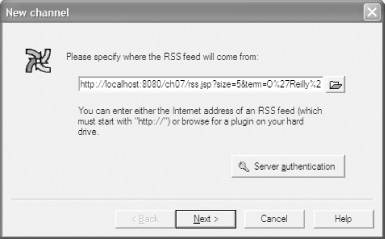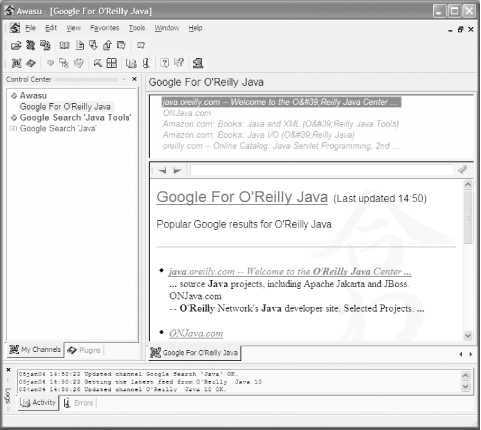7.2 Using an Aggregator
Now that you've seen how the feed is generated, let's use the feed in a more human-friendly format than raw XML. There are a variety of free, open source, shareware and commercial aggregators of RSS feeds available. Figure 7-4 shows how to add the Google feeds to Awasu Personal, a free aggregator for Windows available from http://www.awasu.com/. Awasu retrieves the RSS feeds you subscribed to on a user-defined basis (for example, once an hour, once a day, once a week, etc.).
Figure 7-4. Adding a feed to an aggregator

Once the feed has been added, it's visible along with other feeds, as shown in Figure 7-5.
Figure 7-5. Viewing RSS in an aggregator

There are a variety of other aggregators that serve different purposes:
- Aggie
-
http://bitworking.org/Aggie.html; Windows only
- Aggreg8
-
http://www.aggreg8.net/; based on Mozilla XUL
- AmphetaDesk
-
http://www.disobey.com/amphetadesk/; for Mac OS X, Windows, and Linux
- Bloglines
-
http://www.bloglines.com/; a web site that aggregates for you
- FeedDemon
-
http://www.feeddemon.com/; a commercial, Windows-only reader
- Fetch!
-
http://www.enterpriserss.com/; an "enterprise" RSS package for Windows only
- Friday
-
http://members.bellatlantic.net/~vze3szvh/friday/; a Java-based reader designed for small devices (specifically, devices that support the J2ME standard)
- Genecast
-
http://www.genecast.com/; converts RSS feeds to NNTP (the protocol behind Usenet, a.k.a. "newsgroups")
- Meerkat
-
http://www.oreillynet.com/meerkat/; O'Reilly's open wire service based on RSS
- NetNewsWire
-
http://ranchero.com/netnewswire/; a popular RSS reader for Mac OS X
- Radio Userland
-
http://radio.userland.com/whatIsANewsAggregator; both an aggregator and a weblog tool
If this list doesn't meet your needs, you can find more RSS readers than you can shake a stick at by visiting http://www.lights.com/weblogs/rss.html, which includes among other gems, a Newton-based reader.
In this chapter, we built a bridge service to translate the results from a "pure" web service into RSS feeds, suitable for reading on a variety of devices. Obviously, this is potentially a very powerful solution for many types of problems, but sometimes you'll want to do more than just generate feeds. You'll want to aggregate the data yourself, not just from other RSS feeds, but from a variety of web service sources. We'll do just that in the next chapter.






